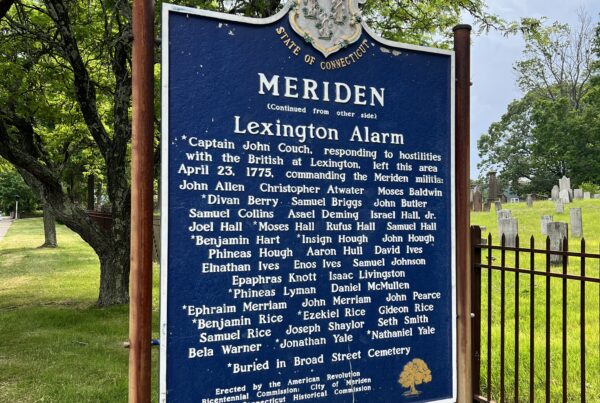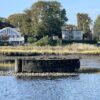
Old Lyme, Connecticut:
“As early as the 1640’s settlers from Saybrook cleared and planted land on the east side of [the] Connecticut River in what is now old Lyme. The first recorded grant of land, in 1649, was to Matthew Griswold in the Black Hall quarter. By 1665 they inhabitants on the east bank, “…desiring to be a plantation by themselves: doe declare that they have a competency of Lands to entertaine thirty families,” and agreed with those on the west bank upon a “loving parting” by which a separate community was established. Two years later the General Court of Connecticut ordered that “…ye plantation on ye River over agt Say-brooke for ye future be named Lyme.” The settlement, some eighty square miles, included the present towns of Old Lyme, East Lyme, Lyme, and part of Salem. The General Court gave consent to Lyme in 1678 to found a church society, which was not formally organized for fifteen years.
Meeting House Hill East of Duck River was the site of two 17th century meetinghouses and one of the 18th. Samuel Belcher designed a fourth, built in 1817, to face the green at the south end of Lyme Street. After it burned in 1907, a replica became as favored a subject for artists as was the original. Seaborne trade began in 1650 with exportation of barrel staves on the ship TRYALL, starting a lucrative commerce with the West Indies. In the 19th century Lyme was divided into four towns. This community in 1855 was named South Lyme, renamed Old Lyme two years later. From a summer colony of artists at the turn of this century evolved the Lyme School of Art, the Lyme Art Association, and the Lyme Academy of Fine Arts. Nearby on Lyme Street stands the Florence Griswold House of 1817, which lodged the artists and is now the headquarters of the Lyme Historical Society, where many of their works may be seen.
Erected by the Town of Old Lyme, the Lyme Historical Society and the Connecticut Historical Commission 1979″
View on Instagram: https://instagr.am/p/Car-V62LZAC/





